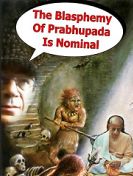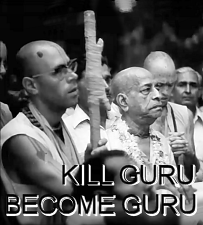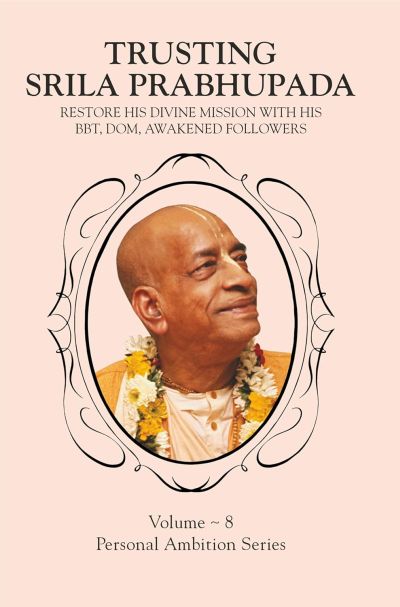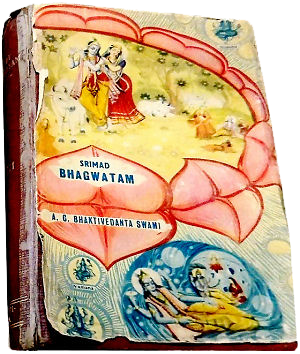Srila Prabhupada describes the authorized Brahma-Madhva-Gaudiya disciplic succession through Sri Isvara Puri
Letters : 1968 Correspondence : February : Letter to: Upendra — Los Angeles 13 February, 1968 : 68-02-13 :
There are four Sampradayas from the beginning of the creation. One is called Brahma Sampradaya, and is coming down by disciplic succession from Brahma; another Sampradaya is coming down from Laksmi, called Sri Sampradaya; another is coming down from the Kumaras, they are known as Nimbarka Sampradaya; another Sampradaya is coming from Lord Siva, Rudra Sampradaya or Vishnu Svami. These are four bona fide Sampradayas that are accepted by the bona fide spiritualists.
The Impersonalist Sampradaya is not original neither the Impersonalist Sampradaya or party can help us. At the present moment there are so many Sampradayas, but we have to test them about their method of disciplic understanding. Anyway, all the four Sampradayas above mentioned, they are after worshiping the Supreme Lord Vishnu, in His different Expansions, and some of them are in favor of worshiping Radha Krishna.
In the later age the Brahma Sampradaya was handed down though Madhva Acarya; in this Madhva Acarya disciplic succession came Isvara Puri. This Isvara Puri was accepted as Spiritual Master of Lord Caitanya. Therefore, we being in disciplic succession of Caitanya Mahaprabhu, we are known as the Madhva Sampradaya. And because Lord Caitanya appeared in Bengal, which country is called Gaudadesa, our Sampradaya party is known as Madhva Gaudiya Sampradaya.
But all these Sampradayas are non-different from one another because they believe and worship the Supreme Lord. Any other Sampradaya who are Impersonalist or voidist or nondevotee, they are rejected by us.
My Guru Maharaja was in the 10th generation from Lord Caitanya. We are 11th from Lord Caitanya. The disciplic succession is as follows: 1. Sri Krishna, 2. Brahma, 3. Narada, 4. Vyasa, 5. Madhva, 6. Padmanabha, 7. Nrihari, 8. Madhava, 9. Akshobhya, 10. Jayatirtha, 11. Jnanasindhu, 12. Purusottama, 13. Vidyanidhi, 14. Rajendra, 15. Jayadharma, 16. Purusottama, 17. Vyasatirtha, 18. Laksmipati, 19. Madhavendra Puri, 20. Isvara Puri (Advaita, Nityananda) 21. Sri Caitanya Mahaprabhu, 22. (Svarupa, Sanatana) Rupa, 23.(Jiva) Raghunath, 24. Krishna dasa, 25. Narottama, 26. Visvanatha, 27. (Baladeva.) Jagannatha, 28. (Bhaktivinode) Gaura-kisora, 29. Srila Bhaktisiddhanta Sarasvati, Sri Barshabhanavidayitadas, 30. Sri Srimad Bhaktivedanta.
Srila Prabhupada describes the exalted position of Isvara Puri
tad vidhehi namas tubhyam
karmasv idyatma-saktisu
yat krtveha yaso visvag
amutra ca bhaved gatih
SYNONYMS
tat–that; vidhehi–give direction; namah–my obeisances; tubhyam–unto you; karmasu–in duties; idya–O worshipful one; atma-saktisu–within our working capacity; yat–which; krtva–doing; iha–in this world; yasah–fame; visvak–everywhere; amutra–in the next world; ca–and; bhavet–it should be; gatih–progress.
O worshipful one, please give us your direction for the execution of duty within our working capacity so that we can follow it for fame in this life and progress in the next.
Purport
Brahma is the direct recipient of Vedic knowledge from the Personality of Godhead, and anyone discharging his entrusted duties in disciplic succession from Brahma is sure to gain fame in this life and salvation in the next. The disciplic succession from Brahma is called the Brahma-sampradaya, and it descends as follows: Brahma, Narada, Vyasa, Madhva Muni (Purnaprajna), Padmanabha, Nrhari, Madhava, Aksobhya, Jayatirtha, Jnanasindhu, Dayanidhi, Vidyanidhi, Rajendra, Jayadharma, Purusottama, Brahmanyatirtha, Vyasatirtha, Laksmipati, Madhavendra Puri, Isvara Puri, Sri Caitanya Mahaprabhu, Svarupa Damodara and Sri Rupa Gosvami and others, Sri Raghunatha dasa Gosvami, Krishnadasa Gosvami, Narottama dasa Thakura, Visvanatha Cakravarti, Jagannatha dasa Babaji, Bhaktivinoda Thakura, Gaurakisora dasa Babaji, Srimad Bhaktisiddhanta Sarasvati, A. C. Bhaktivedanta Swami.
This line of disciplic succession from Brahma is spiritual, whereas the genealogical succession from Manu is material, but both are on the progressive march towards the same goal of Krishna consciousness.
Books : Srimad-Bhagavatam : Canto 3: “The Status Quo” : SB 3.13: The Appearance of Lord Varaha : SB 3.13.8 :
Srila Prabhupada describes the position of Isvara Puri in the Gaudiya Vaishnava parampara,
This is the method of parampara, or disciplic succession. Similarly, Srimad-Bhagavatam explains that Krishna imparted knowledge into the heart of Brahma, the first created creature within the universe. Brahma imparted those lessons to his disciple Narada, and Narada imparted that knowledge to his disciple Vyasadeva.
Vyasadeva imparted it to Madhvacarya, and from Madhvacarya the knowledge has come down to Madhavendra Puri, to Isvara Puri, and from him to Caitanya MahaprabhuBooks : Sri Caitanya-caritamrta – 1975 Edition : Cc. Introduction
Srila Prabhupada explains the appearance of Sri Isvara Puri.
madhava-isvara-puri, saci, jagannatha
advaita acarya prakata haila sei satha
SYNONYMS
madhava–Madhavendra Puri; isvara-puri–Isvara Puri; saci–Sacimata; jagannatha–Jagannatha Misra; advaita acarya–Advaita Acarya; prakata–manifested; haila–were; sei–this; satha–with.
TRANSLATION
Madhavendra Puri, Isvara Puri, Srimati Sacimata and Srila Jagannatha Misra all appeared with Sri Advaita Acarya.
PURPORT
Whenever the Supreme Personality of Godhead descends in His human form, He sends ahead all His devotees, who act as His father, teacher and associates in many roles. Such personalities appear before the descent of the Supreme Personality of Godhead. Before the appearance of Lord Sri Krishna Caitanya Mahaprabhu, there appeared His devotees like Sri Madhavendra Puri; His spiritual master, Sri Isvara Puri; His mother, Srimati Sacidevi; His father, Sri Jagannatha Misra; and Sri Advaita Acarya. Books : Sri Caitanya-caritamrta – 1975 Edition : Cc. Adi-lila : Adi 3: The External Reasons for Lord Caitanya’s Appearance : Adi 3.95
Srila Prabhupada explains the connection between Madhavendra Puri and Isvara Puri
Sri Madhavendra Puri is one of the acaryas in the disciplic succession from Madhvacarya. Madhavendra Puri had two principal disciples, Isvara Puri and Sri Advaita Prabhu. Therefore the Gaudiya Vaisnava-sampradaya is a disciplic succession from Madhvacarya. This fact has been accepted in the authorized books known as Gaura-ganoddesa-dipika and Prameya-ratnavali, as well as by Gopala Guru Gosvami.
The Gaura-ganoddesa-dipika clearly states the disciplic succession of the Gaudiya Vaisnavas as follows: “Lord Brahma is the direct disciple of Vishnu, the Lord of the spiritual sky. His disciple is Narada, Narada’s disciple is Vyasa, and Vyasa’s disciples are Sukadeva Gosvami and Madhvacarya.
Padmanabha Acarya is the disciple of Madhvacarya, and Narahari is the disciple of Padmanabha Acarya. Madhava is the disciple of Narahari, Aksobhya is the direct disciple of Madhava, and Jayatirtha is the disciple of Aksobhya. Jayatirtha’s disciple is Jnanasindhu, and his disciple is Mahanidhi.
Vidyanidhi is the disciple of Mahanidhi, and Rajendra is the disciple of Vidyanidhi. Jayadharma is the disciple of Rajendra. Purusottama is the disciple of Jayadharma. Sriman Laksmipati is the disciple of Vyasatirtha, who is the disciple of Purusottama. And Madhavendra Puri is the disciple of Laksmipati.
Books : Sri Caitanya-caritamrta – 1975 Edition : Cc. Adi-lila : Adi 6: The Glories of Sri Advaita Acarya : Adi 6.40 :
PURPORT
Srila Prabhupapa presents Sri Bhaktivinoda Thakura’s explanation of the flow of the plant of bhakti with Madhavendra Puri and Isvara Puri as the second fructification of the seed of bhakti plant.
A summary of Chapter Nine has been given as follows by Srila Bhaktivinoda Thakura in his Amrta-pravaha-bhasya. In the Ninth Chapter the author of Sri Caitanya-caritamrta has devised a figurative example by describing the “plant of bhakti.” He considers Lord Caitanya Mahaprabhu, who is known as Visvambhara, to be the gardener of this plant because He is the main personality who has taken charge of it.
As the supreme enjoyer, He enjoyed the flowers Himself and distributed them as well. The seed of the plant was first sown in Navadvipa, the birthsite of Lord Caitanya Mahaprabhu, and then the plant was brought to Purusottama-ksetra (Jagannatha Puri) and then to Vrindavana. The seed fructified first in Srila Madhavendra Puri and then his disciple Sri Isvara Puri.
It is figuratively described that both the tree itself and the trunk of the tree are Sri Caitanya Mahaprabhu. The devotees, headed by Paramananda Puri and eight other great sannyasis, are like the spreading roots of the tree.
From the main trunk there extend two special branches, Advaita Prabhu and Sri Nityananda Prabhu, and from those branches grow other branches and twigs. The tree surrounds the entire world, and the flowers of the tree are to be distributed to everyone.
In this way the tree of Lord Caitanya Mahaprabhu intoxicates the entire world. It should be noted that this is a figurative example meant to explain the mission of Lord Caitanya Mahaprabhu
Books : Sri Caitanya-caritamrta – 1975 Edition : Cc. Adi-lila : Adi 9: The Tree of Devotional Service
sri-isvarapuri-rupe ankura pusta haila
apane caitanya-mali skandha upajila
SYNONYMS
sri-isvara-puri–by the name Sri Isvara Puri; rupe–in the form of; ankura–the seed; pusta–cultivated; haila–became; apane–Himself; caitanya-mali–the gardener of the name Sri Caitanya Mahaprabhu; skandha–trunk; upajila–expanded.
TRANSLATION
The seed of devotional service next fructified in the form of Sri Isvara Puri, and then the gardener Himself, Caitanya Mahaprabhu, became the main trunk of the tree of devotional service.
PURPORT
Sri Isvara Puri was a resident of Kumara-hatta, where there is now a railroad station known as Kamarhatta. Nearby there is also another station named Halisahara, which belongs to the Eastern Railway that runs from the eastern section of Calcutta.
Isvara Puri appeared in a brahmana family and was the most beloved disciple of Srila Madhavendra Puri. In the last portion of Sri Caitanya-caritamrta (Antya 8.28-31), it is stated:
isvara-puri gosani kare sri-pada sevana
sva-haste karena mala-mutradi marjananirantara krsna-nama karaya smarana
krsna-nama krsna-lila sunaya anuksanatusta hana puri tanre kaila alingana
vara dila krsne tomara ha-uka prema-dhanasei haite isvara-puri premera sagara
“At the last stage of his life Sri Madhavendra Puri became an invalid and was completely unable to move, and Isvara Puri so completely engaged himself in his service that he personally cleaned up his stool and urine.
Always chanting the Hare Krishna maha-mantra and reminding Sri Madhavendra Puri about the pastimes of Lord Krishna in the last stage of his life, Isvara Puri gave the best service among his disciples.
Thus Madhavendra Puri, being very pleased with him, blessed him, saying, ‘My dear boy, I can only pray to Krishna that He will be pleased with you.’ Thus Isvara Puri, by the grace of his spiritual master, Sri Madhavendra Puri, became a great devotee in the ocean of love of Godhead.”
Srila Visvanatha Cakravarti states in his Gurv-astaka prayer, yasya prasadad bhagavat-prasado yasyaprasadan na gatih kuto ‘pi: “By the mercy of the spiritual master one is blessed by the mercy of Krishna. Without the grace of the spiritual master one cannot make any advancement.”
It is by the mercy of the spiritual master that one becomes perfect, as vividly exemplified here. A Vaisnava is always protected by the Supreme Personality of Godhead, but if he appears to be an invalid, this gives a chance to his disciples to serve him.
Isvara Puri pleased his spiritual master by service, and by the blessings of his spiritual master he became such a great personality that Lord Caitanya Mahaprabhu accepted him as His spiritual master.
Srila Isvara Puri was the spiritual master of Sri Caitanya Mahaprabhu, but before initiating Lord Caitanya he went to Navadvipa and lived for a few months in the house of Gopinatha Acarya.
At that time Lord Caitanya became acquainted with him, and it is understood that he served Sri Caitanya Mahaprabhu by reciting his book, Krishna-lilamrta. This is explained in Sri Caitanya-bhagavata, Adi-lila, Chapter Eleven.
To teach others by example how to be a faithful disciple of one’s spiritual master, Sri Caitanya Mahaprabhu, the Supreme Personality of Godhead, visited the birthplace of Isvara Puri at Kamarhatta and collected some earth from his birthsite. This He kept very carefully, and He used to eat a small portion of it daily.
This is stated in the Caitanya-bhagavata, Adi-lila, Chapter Seventeen. It has now become customary for devotees, following the example of Sri Caitanya Mahaprabhu, to go there and collect some earth from that place.
Books : Sri Caitanya-caritamrta – 1975 Edition : Cc. Adi-lila : Adi 9: The Tree of Devotional Service : Adi 9.11 :
paramananda puri, ara kesava bharati
brahmananda puri, ara brahmananda bharati
visnu-puri, kesava-puri, puri krsnananda
sri-nrsimhatirtha, ara puri sukhananda
ei nava mula nikasila vrksa-mule
ei nava mule vrksa karila niscale
SYNONYMS
paramananda puri–of the name Paramananda Puri; ara–and; kesava bharati–of the name Kesava Bharati; brahmananda puri–of the name Brahmananda Puri; ara–and; brahmananda bharati–of the name Brahmananda Bharati; visnu-puri–of the name Vishnu Puri; kesava-puri–of the name Kesava Puri; puri krsnananda–of the name Krishnananda Puri; sri-nrsimha-tirtha–of the name Sri Nrsimha Tirtha; ara–and; puri sukhananda–of the name Sukhananda Puri; ei nava–of these nine; mula–roots; nikasila–fructified; vrksa-mule–in the trunk of the tree; ei nava mule–in these nine roots; vrksa–the tree; karila niscale–became very steadfast.
TRANSLATION
Paramananda Puri, Kesava Bharati, Brahmananda Puri and Brahmananda Bharati, Sri Vishnu Puri, Kesava Puri, Krishnananda Puri, Sri Nrsimha Tirtha and Sukhananda Puri-these nine sannyasi roots all sprouted from the trunk of the tree. Thus the tree stood steadfastly on the strength of these nine roots.
PURPORT
Paramananda Puri: Paramananda Puri belonged to a brahmana family of the Trihut district in Uttara Pradesh. Madhavendra Puri was his spiritual master. In relationship with Madhavendra Puri, Paramananda Puri was very dear to Sri Caitanya Mahaprabhu. In the Caitanya-bhagavata, Antya-lila, there is the following statement:
sannyasira madhye isvarera priya-patra
ara nahi eka puri gosani se matradamodara-svarupa paramananda-puri
sannyasi-parsade ei dui adhikariniravadhi nikate thakena dui jana
prabhura sannyase kare dandera grahanapuri dhyana-para damodarera kirtana
yata-priti isvarera puri-gosaniredamodara-svarupereo tata priti kare
“Among his sannyasi disciples, Isvara Puri and Paramananda Puri were very dear to Madhavendra Puri.
Thus Paramananda Puri, like Svarupa Damodara, who was also a sannyasi, was very dear to Sri Caitanya Mahaprabhu and was His constant associate. When Lord Caitanya accepted the renounced order, Paramananda Puri offered Him the danda. Paramananda Puri was always engaged in meditation, and Sri Svarupa was always engaged in chanting the Hare Krishna maha-mantra.
As Sri Caitanya Mahaprabhu offered full respect to His spiritual master, Isvara Puri, He similarly respected Paramananda Puri and Svarupa Damodara.” It is described in the Caitanya-bhagavata, Antya-lila, Chapter Three, that when Sri Caitanya Mahaprabhu first saw Paramananda Puri He made the following statement:
aji dhanya locana, saphala aji janma
saphala amara aji haila sarva-dharmaprabhu bale aji mora saphala sannyasa
aji madhavendra more ha-ila prakasa
“My eyes, My mind, My religious activities and My acceptance of the sannyasa order have now all become perfect because today Madhavendra Puri is manifest before Me in the form of Paramananda Puri.” The Caitanya-bhagavata further states:
kathoksane anyo ‘nye karena pranama
paramananda-puri caitanyera priya-dhama
“Thus Sri Caitanya Mahaprabhu exchanged respectful obeisances with Paramananda Puri, who was very dear to Him.” Paramananda Puri established a small monastery behind the western side of the Jagannatha temple, where he had a well dug to supply water. The water, however, was bitter, and therefore Sri Caitanya Mahaprabhu prayed to Lord Jagannatha to allow Ganges water to come into the well to make it sweet.
When Lord Jagannatha granted the request, Lord Caitanya told all the devotees that from that day hence, the water of Paramananda Puri’s well should be celebrated as Ganges water, for any devotee who would drink it or bathe in it would certainly get the same benefit as that derived from drinking or bathing in the waters of the Ganges.
Such a person would certainly develop pure love of Godhead. It is stated in the Caitanya-bhagavata, Antya-lila:
prabhu bale ami ye achiye prthivite
niscaya-i janiha puri-gosanira prite
“Sri Caitanya Mahaprabhu used to say: ‘I am living in this world only on account of the excellent behavior of Sri Paramananda Puri.’ ” The Gaura-ganoddesa-dipika, verse 118, states, puri sri-paramanando ya asid uddhavah pura. “Paramananda Puri is none other than Uddhava.”
Uddhava was Lord Krishna’s friend and uncle, and in caitanya-lila the same Uddhava became the friend of Sri Caitanya Mahaprabhu and His uncle in terms of their relationship in the disciplic succession.
Kesava Bharati: The Sarasvati, Bharati and Puri sampradayas belong to the Srngeri Matha in South India, and Sri Kesava Bharati, who at that time was situated in a monastery in Katwa, belonged to the Bharati-sampradaya.
According to some authoritative opinions, although Kesava Bharati belonged to the Sankara-sampradaya, he had formerly been initiated by a Vaisnava. He is said to have been a Vaisnava on account of having been initiated by Madhavendra Puri, for some say that he took sannyasa from Madhavendra Puri.
The temple and Deity worship started by Kesava Bharati are still existing in the village known as Khatundi, which is under the postal jurisdiction of Kandara in the district of Burdwan. According to the managers of that matha, the priests are descendants of Kesava Bharati, and some say that the worshipers of the Deity are descendants of the sons of Kesava Bharati.
In his householder life he had two sons, Nisapati and Usapati, and a brahmana of the name Sri Nakadicandra Vidyaratna, who was a member of the family of Nisapati, was the priest in charge at the time that Sri Bhaktisiddhanta Sarasvati visited this temple.
According to some, the priests of the temple belong to the family of Kesava Bharati’s brother. Still another opinion is that they descend from Madhava Bharati, who was another disciple of Kesava Bharati’s. Madhava Bharati’s disciple Balabhadra, who also later became a sannyasi of the Bharati-sampradaya, had two sons in his family life, named Madana and Gopala.
Madana, whose family’s surname was Bharati, lived in the village of Auriya, and Gopala, whose family’s surname was Brahmacari, lived in the village of Denduda. There are still many living descendants of both families.
In the Gaura-ganoddesa-dipika, verse 52, it is said:
mathurayam yajna-sutram
pura krsnaya yo munih
dadau sandipanih so ‘bhud
adya kesava-bharati
“Sandipani Muni, who formerly offered the sacred thread to Krishna and Balarama, later became Kesava Bharati.” It is he who offered sannyasa to Sri Caitanya Mahaprabhu. There is another statement from the Gaura-ganoddesa-dipika, verse 117: iti kecit prabhasante ‘krurah kesava-bharati.
“According to some authoritative opinions, Kesava Bharati is an incarnation of Akrura.” Kesava Bharati offered the sannyasa order to Sri Caitanya Mahaprabhu in the year 1432 sakabda (A.D. 1510) in Katwa. This is stated in the Vaisnava-manjusa, Part Two.
Brahmananda Puri: Sri Brahmananda Puri was one of the associates of Sri Caitanya Mahaprabhu while He was performing kirtana in Navadvipa, and he also joined Lord Caitanya in Jagannatha Puri. We may note in this connection that the name Brahmananda is accepted not only by Mayavadi sannyasis but by Vaisnava sannyasis also.
One of our foolish Godbrothers criticized our sannyasi Brahmananda Svami, saying that this was a Mayavadi name. The foolish man did not know that Brahmananda does not always refer to the impersonal. Parabrahman, the Supreme Brahman, is Krishna.
A devotee of Krishna can therefore also be called Brahmananda; this is evident from the fact that Brahmananda Puri was one of the chief sannyasi associates of Lord Caitanya Mahaprabhu.
Brahmananda Bharati: Brahmananda Bharati went to see Sri Krishna Caitanya Mahaprabhu at Jagannatha-dhama. At that time he used to wear only a deerskin to cover himself, and Sri Caitanya Mahaprabhu indirectly indicated that He did not like this deerskin covering.
Brahmananda Bharati therefore gave it up and accepted a loincloth of saffron color, as used by Vaisnava sannyasis. For some time he lived with Sri Caitanya Mahaprabhu at Jagannatha Puri.
Books : Sri Caitanya-caritamrta – 1975 Edition : Cc. Adi-lila : Adi 9: The Tree of Devotional Service : Adi 9.13-15
Sri Isvara Puri ordered two of his disciples to assist Sri Caitanya Mahaprabhu in Jagannatha Puri
tanra siddhi-kale donhe tanra ajna pana
nilacale prabhu-sthane milila asiya
SYNONYMS
tanra siddhi-kale–at the time of Isvara Puri’s passing away; donhe–the two of them; tanra–his; ajna–order; pana–getting; nilacale–at Jagannatha Puri; prabhu-sthane–at the place of Lord Caitanya Mahaprabhu; milila–met; asiya–coming there.
TRANSLATION
In the list of prominent devotees at Nilacala [Jagannatha Puri], Kasisvara was the eighteenth and Govinda the nineteenth. They both came to see Caitanya Mahaprabhu at Jagannatha Puri, being thus ordered by Isvara Puri at the time of his passing away.
Books : Sri Caitanya-caritamrta – 1975 Edition : Cc. Adi-lila : Adi 10: The Trunk, Branches and Subbranches of the Caitanya Tree : Adi 10.139
gurura sambandhe manya kaila dunhakare
tanra ajna mani’ seva dilena donhare
SYNONYMS
gurura sambandhe–in relationship with His spiritual master; manya–honor; kaila–offered; dunhakare–to both of them; tanra ajna–his order; mani‘-accepting; seva–service; dilena–gave them; donhare–the two of them.
TRANSLATION
Both Kasisvara and Govinda were Godbrothers of Sri Caitanya Mahaprabhu, and thus the Lord duly honored them as soon as they arrived. But because Isvara Puri had ordered them to give Caitanya Mahaprabhu personal service, the Lord accepted their service.
Books : Sri Caitanya-caritamrta – 1975 Edition : Cc. Adi-lila : Adi 10: The Trunk, Branches and Subbranches of the Caitanya Tree : Adi 10.140
Sri Isvara Puri is one of the devotees who appeared before Lord Caitanya at the request of Lord krsna.
sri-saci-jagannatha, sri-madhava-puri
kesava bharati, ara sri-isvara puri
advaita acarya, ara pandita srivasa
acaryaratna, vidyanidhi, thakura haridasa
SYNONYMS
sri-saci-jagannatha–Srimati Sacidevi and Jagannatha Misra; sri-madhava puri–Sri Madhavendra Puri; kesava bharati–of the name Kesava Bharati; ara–and; sri-isvara puri–of the name Sri Isvara Puri; advaita acarya–of the name Advaita Acarya; ara–and; pandita srivasa–of the name Srivasa Pandita; acarya-ratna–of the name Acaryaratna; vidyanidhi–of the name Vidyanidhi; thakura haridasa–of the name Thakura Haridasa.
TRANSLATION
Lord Sri Krishna, before appearing as Lord Caitanya, requested these devotees to precede Him: Sri Sacidevi, Jagannatha Misra, Madhavendra Puri, Kesava Bharati, Isvara Puri, Advaita Acarya, Srivasa Pandita, Acaryaratna, Vidyanidhi and Thakura Haridasa:
Books : Sri Caitanya-caritamrta – 1975 Edition : Cc. Adi-lila : Adi 13: The Advent of Lord Sri Caitanya Mahaprabhu : Adi 13.54-55
\
tabeta karila prabhu gayate gamana
isvara-purira sange tathai milana
SYNONYMS
tabeta–thereafter; karila–did; prabhu–Lord Caitanya Mahaprabhu; gayate–to Gaya; gamana–travel; isvara-purira sange–with Isvara Puri; tathai–there; milana–meeting.
TRANSLATION
Thereafter the Lord went to Gaya. There He met Srila Isvara Puri.
PURPORT
Sri Caitanya Mahaprabhu went to Gaya to offer respectful oblations to His forefathers. This process is called pinda-dana. In Vedic society, after the death of a relative, especially one’s father or mother, one must go to Gaya and there offer oblations to the lotus feet of Lord Vishnu. Therefore hundreds and thousands of men gather in Gaya daily to offer such oblations, or sraddha. Following this principle, Lord Caitanya Mahaprabhu also went there to offer pinda to His dead father.
Fortunately He met Isvara Puri there.
Books : Sri Caitanya-caritamrta – 1975 Edition : Cc. Adi-lila : Adi 17: The Pastimes of Lord Caitanya Mahaprabhu in His Youth : Adi 17.8
diksa-anantare haila, premera prakasadese agamana punah premera vilasa
SYNONYMS
diksa–initiation; anantare–immediately after; haila–became; premera–of love of Godhead; prakasa–exhibition; dese–in His home country; agamana–coming back; punah–again; premera–of love of God; vilasa–enjoyment.
TRANSLATION
In Gaya, Sri Caitanya Mahaprabhu was initiated by Isvara Puri, and immediately afterwards He exhibited signs of love of Godhead. He again displayed such symptoms after returning home.
PURPORT
When Sri Caitanya Mahaprabhu went to Gaya, accompanied by many of His disciples, He became sick on the way. He had such a high fever that He asked His students to bring water that had washed the feet of brahmanas, and when they brought it the Lord drank it and was cured.
Therefore everyone should respect the position of a brahmana, as indicated by Sri Caitanya Mahaprabhu. Neither the Lord nor His followers displayed any disrespect to brahmanas.
The followers of the Lord must be prepared to offer brahmanas all due respect. But preachers of Lord Caitanya’s cult object if someone presents himself as a brahmana without having the necessary qualifications. The followers of Lord Caitanya cannot blindly accept that everyone born in a brahmana family is a brahmana.
Therefore one should not indiscriminately follow the Lord’s example of showing respect to brahmanas by drinking water that has washed their feet.
Gradually the brahmana families have become degraded because of the contamination of Kali-yuga. Thus they misguide people by exploiting their sentiments.
Books : Sri Caitanya-caritamrta – 1975 Edition : Cc. Adi-lila : Adi 17: The Pastimes of Lord Caitanya Mahaprabhu in His Youth : Adi 17.9
Sri Caitanya Mahaprabhu heard the narration of Saksi Gopala from Isvara Puri
mahaprasada-ksira-lobhe rahila prabhu tatha
purve isvara-puri tanre kahiyachena katha
SYNONYMS
maha-prasada–for the remnants of food; ksira–sweet rice; lobhe–in eagerness; rahila–remained; prabhu–the Lord; tatha–there; purve–before that; isvara-puri–Isvara Puri, His spiritual master; tanre–unto Him; kahiyachena–told; katha–a narration.
TRANSLATION
The Lord remained there because He was very eager to receive the remnants of sweet rice offered to the Gopinatha Deity, having heard a narration from His spiritual master, Isvara Puri, of what had once happened there
Books : Sri Caitanya-caritamrta – 1975 Edition : Cc. Madhya-lila : Madhya 4: Sri Madhavendra Puri’s Devotional Service : Madhya 4.18
Srila Prabhupada explains the unique contribution of Sri Madhavendra Puri and Sri Isvara Puri in the Gaudiya Sampradaya.
ayi dina-dayardra natha he
mathura-natha kadavalokyase
hrdayam tvad-aloka-kataram
dayita bhramyati kim karomy aham
SYNONYMS
ayi–O My Lord; dina–on the poor; daya-ardra–compassionate; natha–O master; he–O; mathura-natha–the master of Mathura; kada–when; avalokyase–I shall see You; hrdayam–My heart; tvat–of You; aloka–without seeing; kataram–very much aggrieved; dayita–O most beloved; bhramyati–becomes overwhelmed; kim–what; karomi–shall do; aham–I.
TRANSLATION
“O My Lord! O most merciful master! O master of Mathura! When shall I see You again? Because of My not seeing You, My agitated heart has become unsteady. O most beloved one, what shall I do now?”
PURPORT
The uncontaminated devotees who strictly depend on the Vedanta philosophy are divided into four sampradayas, or transcendental parties. Out of the four sampradayas, the Sri Madhvacarya-sampradaya was accepted by Madhavendra Puri.
Thus he took sannyasa according to parampara, the disciplic succession. Beginning from Madhvacarya down to the spiritual master of Madhavendra Puri, the acarya named Laksmipati, there was no realization of devotional service in conjugal love.
Sri Madhavendra Puri introduced the conception of conjugal love for the first time in the Madhvacarya-sampradaya, and this conclusion of the Madhvacarya-sampradaya was revealed by Sri Caitanya Mahaprabhu when He toured southern India and met the Tattvavadis, who supposedly belonged to the Madhvacarya-sampradaya.
When Sri Krishna left Vrindavana and accepted the kingdom of Mathura, Srimati Radharani, out of ecstatic feelings of separation, expressed how Krishna can be loved in separation. Thus devotional service in separation is central to this verse.
Worship in separation is considered by the Gaudiya-Madhva sampradaya to be the topmost level of devotional service. According to this conception, the devotee thinks of himself as very poor and neglected by the Lord. Thus he addresses the Lord as dina-dayardra natha, as did Madhavendra Puri.
Such an ecstatic feeling is the highest form of devotional service. Because Krishna had gone to Mathura, Srimati Radharani was very much affected, and She expressed Herself thus: “My dear Lord, because of Your separation My mind has become overly agitated.
Now tell Me, what can I do? I am very poor and You are very merciful, so kindly have compassion upon Me and let Me know when I shall see You.” Sri Caitanya Mahaprabhu was always expressing the ecstatic emotions of Srimati Radharani that She exhibited when She saw Uddhava at Vrindavana.
Similar feelings, experienced by Madhavendra Puri, are expressed in this verse. Therefore, Vaisnavas in the Gaudiya-Madhva sampradaya say that the ecstatic feelings experienced by Sri Caitanya Mahaprabhu during His appearance came from Sri Madhavendra Puri through Isvara Puri.
All the devotees in the line of the Gaudiya-Madhva sampradaya accept these principles of devotional service: Sri Madhavendra Puri’s Devotional Service : Madhya 4.197 : PURPORT
Srila Prabhupada explains the relationship between Sri Isvara Puri, Sri Caitanya Mahaprabhu and His two disciples Govinda and Kasivara Gsowami.
eta suni’ sarvabhauma prabhure puchila
puri-gosani sudra-sevaka kanhe ta’ rakhila
SYNONYMS
eta suni‘-hearing this; sarvabhauma–Sarvabhauma Bhattacarya; prabhure–unto the Lord; puchila–inquired; puri-gosani–Isvara Puri; sudra-sevaka–a servant who is a sudra; kanhe ta’–why; rakhila–kept.
TRANSLATION
After hearing this, Sarvabhauma Bhattacarya asked Sri Caitanya Mahaprabhu, “Why did Isvara Puri keep a servant who comes from a sudra family?”
PURPORT
Both Kasisvara and Govinda were personal servants of Isvara Puri. After Isvara Puri’s demise, Kasisvara went to visit all the holy places of India. Following the orders of his spiritual master, Govinda immediately went to Sri Caitanya Mahaprabhu for shelter.
Govinda came from a sudra family, but because he was initiated by Isvara Puri, he was certainly a brahmana. Sarvabhauma Bhattacarya here asked Sri Caitanya Mahaprabhu why Isvara Puri accepted a disciple from a sudra family. According to the smrti-sastra, which gives directions for the management of the varnasrama institution, a brahmana cannot accept a disciple from the lower castes.
In other words, a ksatriya, vaisya or sudra cannot be accepted as a servant. If a spiritual master accepts such a person, he is contaminated. Sarvabhauma Bhattacarya therefore asked why Isvara Puri accepted a servant or disciple born of a sudra family.
In answer to this question, Sri Caitanya Mahaprabhu replied that His spiritual master, Isvara Puri, was so empowered that he was as good as the Supreme Personality of Godhead.
As such, Isvara Puri was the spiritual master of the whole world. He was not a servant of any mundane rule or regulation. An empowered spiritual master like Isvara Puri can bestow his mercy upon anyone, irrespective of caste or creed.
The conclusion is that a spiritual master who is authorized and empowered by Krishna and his own guru should be considered as good as the Supreme Personality of Godhead Himself. That is the verdict of Visvanatha Cakravarti: saksad-dharitvenasa. An authorized spiritual master is as good as Hari, the Supreme Personality of Godhead.
As Hari is free to act as He likes, the empowered spiritual master is also free. As Hari is not subject to mundane rules and regulations, the spiritual master empowered by Him is also not subject. According to the Caitanya-caritamrta (Antya-lila 7.11), krsna-sakti vina nahe tara pravartana.
An authorized spiritual master empowered by Krishna can spread the glories of the holy name of the Lord, for he has power of attorney from the Supreme Personality of Godhead. In the mundane world, anyone possessing his master’s power of attorney can act on behalf of his master.
Similarly, a spiritual master empowered by Krishna through his own bona fide spiritual master should be considered as good as the Supreme Personality of Godhead Himself. That is the meaning of saksad-dharitvena.
Sri Caitanya Mahaprabhu therefore describes the activities of the Supreme Personality of Godhead and the bona fide spiritual master as follows books:
Sri Caitanya-caritamrta – 1975 Edition : Cc. Madhya-lila : Madhya 10: The Lord’s Return to Jagannatha Puri : Madhya 10.136 :
TRANSLATION
Sri Isvara Puri and Isvara are both completely independent.
Prabhu kahe,-isvara haya parama svatantra
isvarera krpa nahe veda-paratantra
SYNONYMS
prabhu kahe–Sri Caitanya Mahaprabhu said; isvara–the Supreme Personality of Godhead or Isvara Puri; haya–is; parama–supremely; svatantra–independent; isvarera–of the Supreme Personality of Godhead or of Isvara Puri; krpa–the mercy; nahe–is not; veda-paratantra–subject to the Vedic rules.
TRANSLATION
Sri Caitanya Mahaprabhu said, “Both the Supreme Personality of Godhead and My spiritual master, Isvara Puri, are completely independent. Therefore neither the mercy of the Supreme Personality of Godhead nor that of Isvara Puri is subject to any Vedic rules or regulations.
Books : Sri Caitanya-caritamrta – 1975 Edition : Cc. Madhya-lila : Madhya 10: The Lord’s Return to Jagannatha Puri : Madhya 10.137 :







Speak Your Mind